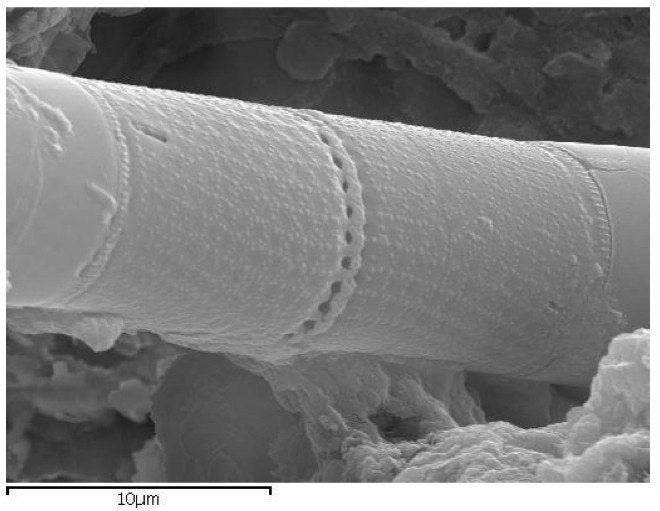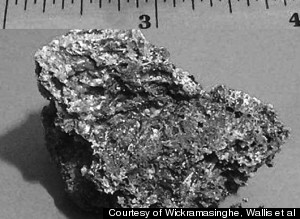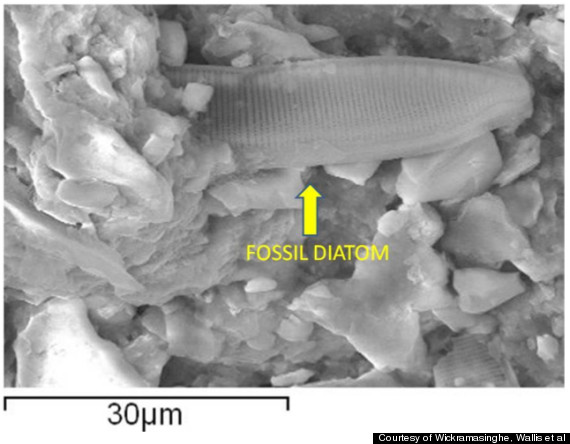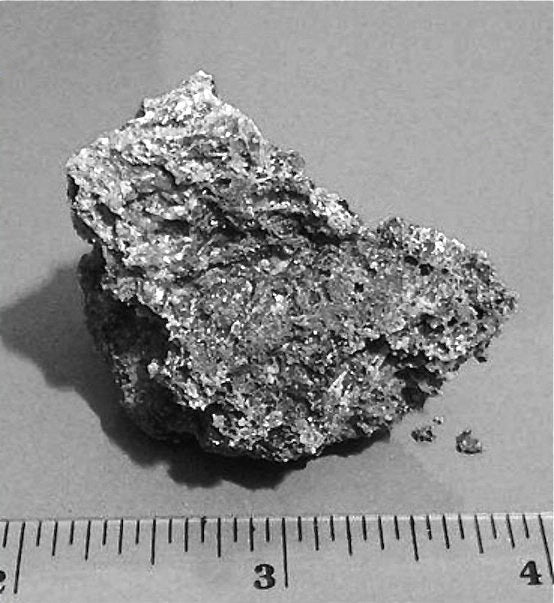
If a group of scientists are correct, tiny fossils uncovered inside a meteorite found in Sri Lanka in December are proof of extraterrestrial life.
In a detailed paper called "Fossil Diatoms In A New Carbonaceous Meteorite" that is appearing in the Journal of Cosmology, Chandra Wickramasinghe claims to have found strong evidence that life exists throughout the universe.
An electron microscope was used to study the reported remains of a large meteorite (see image below right) that fell near the Sri Lanka village of Polonnaruwa on Dec. 29.

Wickramasinghe is the director of the Buckingham Centre for Astrobiology at the University of Buckingham in the U.K. In December, he and his colleagues found "a microstructure and morphology characteristic of a wide class of terrestrial diatoms." The group concluded that "the presence of structures of this kind in any extraterrestrial setting could be construed as unequivocal proof of biology" -- in other words, proof of life outside of planet Earth.
Wickramasinghe and the late English astronomer Sir Fred Hoyle co-developed a theory known as "panspermia," which suggests that life exists throughout the universe and is distributed by meteoroids and asteroids.
"We conclude ... that the identification of fossilised diatoms [as shown in the image below] in the Polonnaruwa meteorite is firmly established and unimpeachable. Since this meteorite is considered to be an extinct cometary fragment, the idea of microbial life carried within comets and the theory of cometary panspermia is thus vindicated," Wickramasinghe wrote in the research paper.

But with any remarkable claim comes criticism of the scientist's research and conclusions.
Astronomer Phil Plait, writing in Slate magazine, raised several red flags and called into question the validity of Wickramasinghe's findings.
"Wickramasinghe is a fervent proponent of [panspermia]. Like, really fervent. So much so that he attributes everything to life in space," Plait wrote. "He's claimed living cells found in the stratosphere come from space. (There is no evidence at all they do, and it's far more likely they are terrestrial). ... Wickramasinghe jumps on everything, with little or no evidence, and says it's from outer space, so I think there's a case to be made for a bias on his part."

The Huffington Post contacted Wickramasinghe in the U.K. and asked him to respond to some of the criticisms leveled at him by Plait, beginning with Plait's assertion that Wickramasinghe is biased in his notion that there is an abundance of life in outer space.
"In 1962, [Hoyle and I] pioneered the theory of carbon grains in space to replace the old ice grain theory. This was vehemently resisted by the astronomical community at the outset, but with the dawn of infrared spectroscopy, the ice grain theory gave way to the carbon dust theory," Wickramasinghe told HuffPost in an email.
"Over a few years, after a great deal of model-fitting, we came to the conclusion that material similar to biomaterial fitted all the available data in astronomy ... We considered the possibility that biology (microbiology) had a universal character, and no observations in astronomy or new information from biology has provided contrary evidence."
In an earlier research paper he co-authored in 2012, Wickramasinghe wrote, "For nearly five decades evidence in favor of a non-terrestrial origin of life and panspermia has accumulated which has not been properly assessed. A point has now been reached that demands the serious attention of biologists to a possibly transformative paradigm shift of the question of the origin of life, with profound implications across many disciplines."
"If only ideas that are considered orthodox are given support through award of grants or publication opportunities, it is certain that the progress of science will be stifled as it was throughout the middle ages," Wickramasinghe wrote to HuffPost.
Check out these engaging images of the Polonnaruwa meteorite fossils
Plait claims that the diatoms Wickramasinghe found, "a type of algae, microscopic plant life," are simply a freshwater species found on Earth. Wickramasinghe doesn't deny that the meteorite sample his team studied contains freshwater diatoms.
"But -- there are also at least half a dozen species that diatom experts have not been able to identify," Wickramasinghe said.
Critics have also asserted that the meteorite in question may not, in fact, be from outer space. Could it simply be an Earth rock?
According to Wickramasinghe, "This was also the guess of the Sri Lankan geologists who first looked at the rock. They had considered the possibility that the rock may be ... a rock that was struck by lightning. We examined this possibility and found it to be untenable. From all the evidence we possess (and we are planning to publish this), I personally have no doubt whatsoever that this was a stone that fell from the skies."
The microscopic images produced from the Sri Lankan meteorite are certainly provocative -- as also seen in the video below -- but whether or not they truly prove the existence of extraterrestrial life will remain controversial until enough scientists sign off on the theory ... or not.

